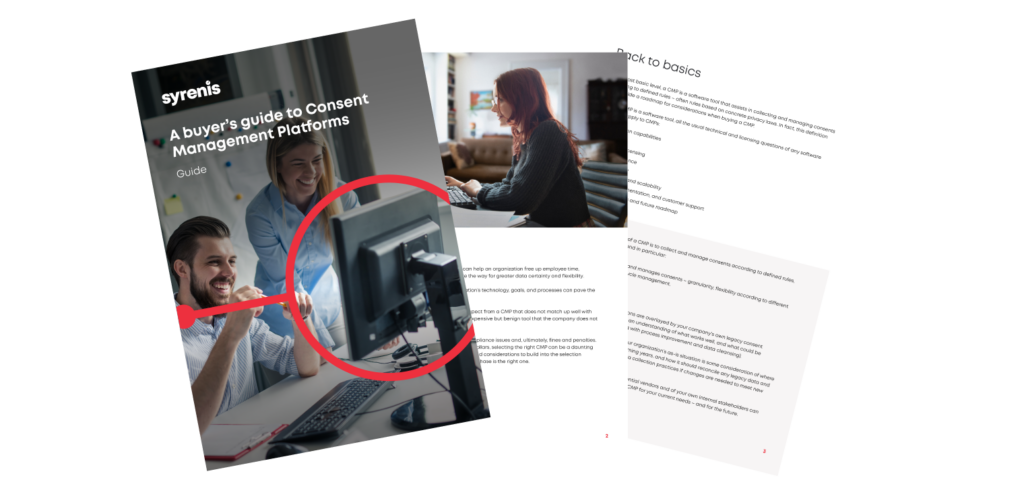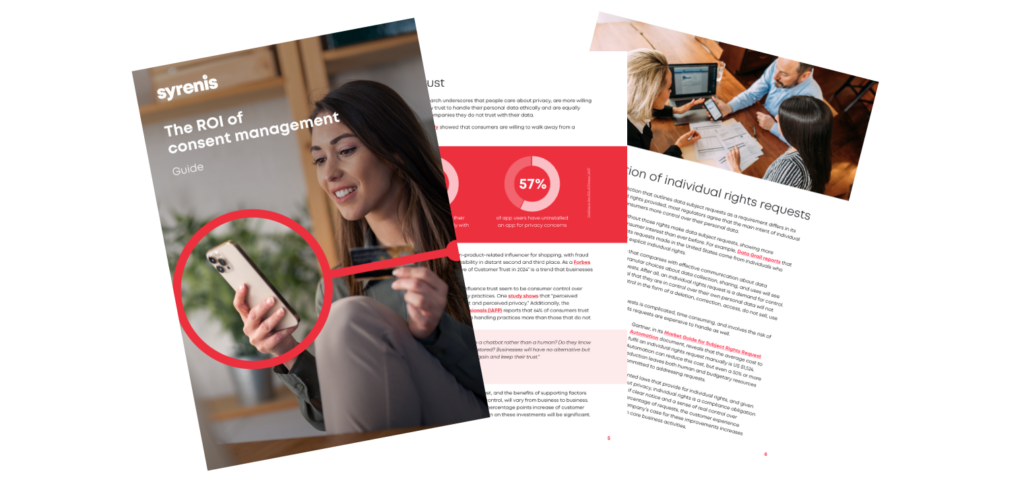How to choose a consent management platform
Posted: June 27, 2022
Global regulators are tightening the rules. Consumers are demanding transparency. And the stakes? Your reputation, your revenue, and your relevance. Privacy isn’t just a legal requirement anymore – it’s a core expectation and a competitive differentiator.
At the heart of every successful privacy strategy is a powerful consent management platform (CMP). It’s the engine that drives compliant data collection, builds consumer trust, and keeps your business aligned with ever-evolving regulations. But not all CMPs are created equal.
Choosing the right platform isn’t just a tech decision – it’s a strategic one. A misaligned CMP can disrupt operations, stall innovation, and expose you to serious risk. The right one? It scales with your growth, integrates seamlessly with your stack, and unlocks new opportunities.
In this blog, we’ll show you how to choose a CMP that doesn’t just tick boxes – but transforms your privacy program into a business advantage.
Jump to:
- What is a consent management platform?
- Key features of a good consent management solution
- How to integrate your business and CMP together seamlessly
- Why choosing the right CMP matters
What is a consent management platform?
Forming a significant part of several global privacy legislations, such as the EU’s General Data Protection Regulation (GDPR), and the California Consumer Protection Act (CCPA), consent sits at the core of any compliant data privacy practice.
When your business handles data from thousands, or even millions, of users, managing consent manually isn’t an option. Instead, implementing a consent management platform to manage consumer consent data at scale can be a highly effective means of handling consent whilst aligning with global privacy legislation.
As defined by Gartner®, a consent management platform is designed to ‘support all aspects of collecting, consolidating, synchronizing and applying end-user choices about personal data’. This means that alongside simply collecting consumer consent data, a consent management platform ensures that choices are honored across all systems and touchpoints.
Central to mitigating the risks of non-compliance, a consent management platform helps maintain compliance with global regulations, enabling businesses to build trust through transparent data practices.
However, to ensure a consent management platform aligns with your business objectives, it’s essential to evaluate core functionalities.
Key features of a good consent management solution
With a wide array of solutions on the market, each offering distinct features, it’s crucial to assess your specific needs to identify the right-fit vendor for consent management.
Key features to look out for include customizable consent banners, granular consent options, real-time consent logs and reporting, as well as integration with existing technologies.
Customizable consent banners
Impacting both regulatory compliance and user experience, customizable consent banners are a key feature to look out for when selecting a consent management platform.
- Regulatory compliance: From a compliance perspective, a customizable consent banner allows you to adapt language, layout, and consent options in order to meet specific legal standards, as well as include or exclude consent categories as required.
- User experience: Use customizable consent banners in your CMP to optimize placement, timing, and messaging to reduce friction, and use A/B testing to find the most effective consent language and layout.
- Brand consistency: Align your consent banner with your branding to maintain a seamless user experience, reinforce brand trust, and avoid jarring or intrusive designs that may lead to increased bounce rates.
Granular consent options
A consent management platform that provides users with granular consent options is essential for boosting engagement and long-term retention.
- Put users in control: By allowing individuals to selectively agree to specific data uses, such as analytics, marketing, or personalization, businesses empower users to take control of their privacy.
- Gain strategic insight: With more precise consent data, organizations can gain deeper insights into user preferences, enabling smarter audience segmentation and more effective marketing and personalization strategies.
Real-time consent logs and reporting
Choosing a consent management platform with real-time consent logs and reporting features is vital for maintaining compliance.
- Improved data governance: These capabilities provide immediate visibility into user consent statuses, enabling businesses to track, audit, and respond to consent changes as they happen. This not only ensures alignment with evolving privacy regulations but also supports faster incident response and more accurate data governance.
- Monitor and optimize consent flows: Additionally, detailed reporting empowers teams with actionable insights, helping to identify trends, optimize consent flows, and demonstrate accountability to regulators and stakeholders alike.
Integration with existing technologies
It’s important to choose a consent management platform that can integrate with your existing digital estate in order to consolidate consent data into a single source of truth.
- Sync consent data across platforms: Consent signals are automatically synchronized across your CRM, analytics tools, tag managers, and other systems, reducing manual effort and the risk of data discrepancies.
- Integration efficiencies: Integration streamlines implementation, allowing teams to deploy and manage consent workflows without disrupting existing processes.
- Central source of truth: Integrating your CMP with existing technologies supports a unified data strategy by ensuring that only consented data is used across all platforms, enhancing compliance and trust.
How to integrate your business and CMP together seamlessly
Aligning your business systems with a consent management platform doesn’t have to be a daunting task. A smooth CMP implementation starts with a structured approach that fully addresses your business requirements.
1. Assess your current digital tech stack
When integrating a consent management platform into your business, you must identify all platforms that collect or process personal data, such as your CRM, website, or ad platforms.
Once you’ve mapped out your data flows, the next step is to identify exactly where consent needs to be collected and enforced. This might include consent for receiving marketing communications, participating in analytics tracking, or agreeing to targeted advertising.
To ensure compliance and consistency, it’s essential that your consent management platform integrates seamlessly with all existing technologies. This integration enables real-time syncing of consent data across systems, creating a centralized, reliable source of truth.
2. Test and monitor consent flows
Once you’ve successfully integrated your consent management platform with existing platforms and third-party systems, be sure to monitor any consent data flowing in and out of these platforms. This ensures that user preferences are being accurately captured, stored, and respected at every touchpoint.
Ongoing monitoring not only supports compliance but also helps maintain a consistent and trustworthy user experience.
3. Train teams and document processes
Keeping a clear, up-to-date record of all processes related to your CMP helps ensure consistency, accountability, and alignment across departments.
It’s equally important to define specific use cases for each team involved. For example, your IT team may focus on system integration and data flow monitoring, while compliance teams will be more concerned with audit trails and regulatory alignment. Meanwhile, marketing teams will rely on the CMP to manage consent for campaign targeting and personalization. By outlining these role-specific responsibilities, you can ensure that each team understands how to use the platform effectively and in line with their objectives.
Why choosing the right CMP matters
Consent has evolved – from a compliance checkbox to a strategic growth lever. Today, effective consent management doesn’t just keep regulators happy – it unlocks richer audience insights, sharper marketing, and stronger customer relationships.
The right CMP helps you strike the perfect balance between compliance and innovation. It streamlines operations, reduces risk, and adapts to your unique business needs – all while keeping pace with global privacy laws.
But the benefits go far beyond legal alignment:
- Marketing teams can use consent data to deliver hyper-personalized content that boosts engagement and conversions.
- IT teams gain real-time visibility and reporting to manage risk and ensure data integrity.
- Compliance teams get audit-ready transparency and peace of mind.
The right CMP empowers your entire organization, bringing clarity, agility, and trust to your data strategy – making it a must-have for any business looking to innovate with confidence.



